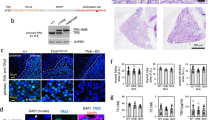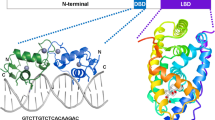Abstract
THE nuclear receptors for 1,25-dihydroxyvitamin D3 (YD) and 3,5,3′-triiodothyronine (T3), that is, VDRs and T3Rs respectively, control aspects of homeostasis, cell growth and differentiation1–4. They activate transcription from response elements consisting of direct repeats, palindromes and inverted palindromes5–8 of a variety of hexameric core-binding motifs. VDRs bind preferentially to direct repeats spaced by three nucleotides, whereas T3Rs bind to direct repeats spaced by four nucleotides9. VDRs and T3Rs can function as homodimers5,6,10but heterodimerization with retinoid X11–14 or retinoic acid receptors15,16 increases their affinity for DNA in vitro and resulting transcriptional activity in vivo. We recently observed the formation of VDR–T3R heterodimers17. Here we show that the polarity of the binding of such heterodimers to the VD response element of the rat 9K (relative molecular mass 9,000) calbindin18 gene promoter was 5′-T3R–VDR-3′, whereas on the mouse 28K calbindin VD response element19 this polarity was reversed to 5′-VDR–T3R-3′. We also show that the ligand for the downstream receptor controls the transcriptional activity of the heterodimeric complex. Thus, polarity seems to be an important regulatory property of heterodimeric nuclear receptor complexes.
This is a preview of subscription content, access via your institution
Access options
Subscribe to this journal
Receive 51 print issues and online access
$199.00 per year
only $3.90 per issue
Buy this article
- Purchase on Springer Link
- Instant access to full article PDF
Prices may be subject to local taxes which are calculated during checkout
Similar content being viewed by others
References
Pike, J. W. A. Rev. Nutr. 11, 189–216 (1991).
Norman, A. W. et al. J. Steroid Biochem. molec. Biol. 41, 231–240 (1992).
Glass, C. K. & Holloway, J. M. Biochim. biophys. Acta 1032, 157–176 (1990).
Lazar, M. A. Endocrine Rev. 14, 184–193 (1993).
Carlberg, C. et al. Nature 361, 657–660 (1993).
Carlberg, C. Biochem. biophys. Res. Commun. 195, 1345–1353 (1993).
Schräder, M. & Carlberg, C. DNA Cell Biol. 13, 333–341 (1994).
Schräder, M., Müller, K. M., Becker-André, M. & Carlberg, C. J. molec. Endocr. 12, 327–339 (1994).
Umesono, K., Murakami, K. K., Thompson, C. C. & Evans, R. M. Cell 65, 1255–1266 (1991).
Forman, B. M., Casanova, J., Raaka, B. M., Ghysdael, J. & Samuels, H. H. Molec. Endocr. 6, 429–442 (1992).
Yu, V. C. et al. Cell 67, 1251–1266 (1991).
Zhang, X.-K., Hoffmann, B., Tran, P. B.-V., Graupner, G. & Pfahl, M. Nature 355, 441–446 (1992).
Kliewer, S. A., Umesono, K., Mangelsdorf, D. J. & Evans, R. M. Nature 355, 446–449 (1992).
Leid, M. et al. Cell 68, 377–395 (1992).
Glass, C. K., Lipkin, S. M., Devary, O. V. & Rosenfeld, M. G. Cell 59, 697–708 (1989).
Schräder, M., Bendik, I., Becker-André, M. & Carlberg, C. J. biol. Chem. 268, 17830–17836 (1993).
Schräder, M., Müller, K. M. & Carlberg, C. J. biol. Chem. 269, 5501–5504 (1994).
Darwish, H. M. & DeLuca, H. F. Proc. natn. Acad. Sci. U.S.A. 89, 603–607 (1992).
Gill, R. K. & Christakos, S. Proc. natn. Acad. Sci. U.S.A. 90, 2984–2988 (1993).
Schräder, M., Becker-André, M. & Carlberg, C. J. biol. Chem. 269, 6444–6449 (1994).
Kurokawa, R. et al. Genes Dev. 7, 1423–1435 (1993).
Forman, B. M. & Samuels, H. H. Molec. Endocr. 4, 1293–1301 (1990).
Zechel, C. et al. EMBO J. 13, 1425–1433 (1994).
Perlmann, T., Rangarajan, P. N., Umesono, K. & Evans, R. M. Genes Dev. 7, 1411–1422 (1993).
Mader, S. et al. EMBO J. 12, 5029–5041 (1993).
Predki, P. F., Zamble, D., Sarkar, B. & Giguère, V. Molec. Endocr. 8, 31–39 (1994).
Leid, M., Kastner, P. & Chambon, P. Trends Biochem. 17, 427–433 (1992).
Varghese, S., Lee, S., Huang, Y.-C. & Christakos, S. J. biol. Chem. 263, 9776–9784 (1988).
Luckow, B. & Schütz, G. Nucleic Acids Res. 15, 5490 (1987).
Pothier, F., Ouellet, M., Julien, J.-P. & Guérin, S. L. DNA Cell Biol. 11, 83–90 (1992).
Author information
Authors and Affiliations
Rights and permissions
About this article
Cite this article
Schräder, M., Müller, K., Nayeri, S. et al. Vitamin D3-thyroid hormone receptor heterodimer polarity directs ligand sensitivity of transactivation. Nature 370, 382–386 (1994). https://doi.org/10.1038/370382a0
Received:
Accepted:
Issue Date:
DOI: https://doi.org/10.1038/370382a0
This article is cited by
-
Bile acids in glucose metabolism and insulin signalling — mechanisms and research needs
Nature Reviews Endocrinology (2019)
-
Thyroid hormone action in metabolic regulation
Protein & Cell (2011)
-
The vitamin D3 receptor in the context of the nuclear receptor superfamily
Endocrine (1996)
-
Structural determinants of nuclear receptor assembly on DNA direct repeats
Nature (1995)
-
New insights into the structure and function of the thyroid hormone receptor
Journal of Biomedical Science (1995)
Comments
By submitting a comment you agree to abide by our Terms and Community Guidelines. If you find something abusive or that does not comply with our terms or guidelines please flag it as inappropriate.



